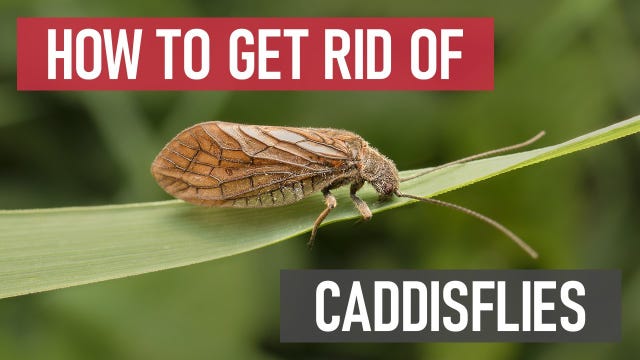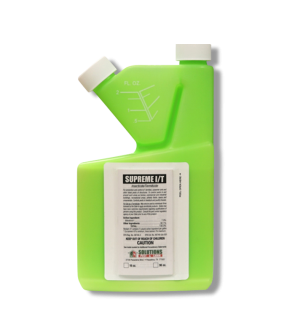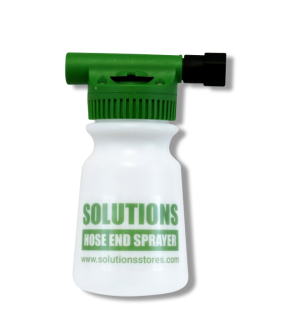Gain access to personalized product screening, the best pricing, rewards, and more!
Most Effective Products
Caddisfly Control: How To Get Rid of Caddisflies
This page is a general caddisfly control guide. Using the suggested products and methods will reduce the likelihood of caddisflies. Follow this guide and use the recommended products; we guarantee a great reduction in the population of caddisflies.
If you own or live near a pond or a lake, you may have noticed a winged cream-colored insect that swarms in huge numbers and looks similar to a moth. That insect is a caddisfly, also known as sedge flies, rail flies, shadflies, or periwinkles. Despite their name, these insects are not actually flies they are moth-like insects from the order Trichoptera. Flies have only 1 pair of wings, while caddisflies have 2 pairs.
While these insects mainly stay near bodies of water, they may wander off and end up in homes, where they can be a troublesome pest, especially when they swarm in large numbers.
Caddisflies are heavily attracted to light and may have wandered away from their aquatic habitats due to the lure of home lighting. They do not harm people with stings or bites or damage structures, but they can be a nuisance when present.
While adult caddisflies only live for a few days once they reach adulthood, they do not breed and develop inside homes and buildings. Caddisfly swarms can occur practically any time of the year, so if they are a problem for you, hoping for a season of relief may not happen.
If you have a caddisfly issue in or around your home, there is a way to get rid of them. Our DIY guide below covers how to handle them and the best products for controlling them.
Identification
Before progressing with treatment, you need to be certain that you are dealing with a caddisfly and not some other insect. Listed below are some common traits of caddisflies:

- Caddisfly adults are long and slender and can range between 3 to 15 millimeters in length. They are usually dull in color, ranging from brown to gray or black. Depending on the species, the patterns will vary.
- Their most distinguishing feature is their wings, which are covered in fine hairs rather than scales like moths and butterflies. The posterior wings are often more broad than the anterior wings. The wings are typically longer than their bodies at up to 20 millimeters, and their wingspans can reach up to 40 millimeters long. These wings are held roof-like over their bodies when at rest, giving them a tent-like appearance. Caddisflies also have long, threadlike antennae that can be as long as or longer than their bodies, as well as slender, soft bodies and long, spindly legs.
- Caddisfly larvae are aquatic and spend their lives underwater, where many species build protective cases from natural materials like sand, twigs, or plant debris. The larvae with their cases can reach lengths ranging from 3 to 40 millimeters. They have gills for breathing underwater and typically live in streams or lakes. Because caddisfly larvae require clean, well-oxygenated water to thrive, their presence is often used as a sign of good water quality. Caddisfly larvae have soft, worm-like bodies with hardened head capsules and three pairs of legs near the front of their bodies.
Use the description and image above to help you identify caddisflies on your property. If you are unsure, contact our experts; we will help you identify the pest infestation you are facing.
Inspection
Inspection of your property is crucial for complete control. During the inspection, you will identify areas that caddisflies might be attracted to after they hatch and fix them to prevent most of the swarm from contacting your property.
 Where To Inspect
Where To Inspect
Caddisflies are closely associated with freshwater environments, as their larvae are aquatic and require clean, well-oxygenated water to survive.
Check your property for bodies of water or where water in your yard pools and doesn’t drain properly, such as after rain.
Common habitats for caddisflies include streams, rivers, lakes, ponds, springs, wetlands, or even ornamental water features like garden ponds or fountains. They are especially abundant in cool, fast-flowing streams and creeks, where the water is clear and rich in oxygen.
Caddisflies can sometimes be found in yards, but only under certain conditions mainly if there’s a nearby water source. If your yard is close to one of these habitats, especially if the water is clean and well-oxygenated, adult caddisflies may be seen resting on plants, walls, windows, or light fixtures.
What To Look For
Adult caddisflies are attracted to lights at night, so they may gather around porch lights or windows, especially in warm months. However, they do not breed or live in the soil or grass like some lawn pests, nor do they harm plants or structures.
You might also see them indoors if they’ve been attracted to lights and entered through screens or open doors.
Inspect rocks, aquatic plants, and the bottom of the pond or water feature for small, tube-like cases made of sand, twigs, or debris for caddisflies larvae.
Treatment
Once you have confirmed the conducive conditions that attract caddisflies, it is time to treat them. Remember to read all product labels, follow the application instructions on these labels, and stay safe by wearing personal protective equipment.
Controlling caddisflies typically focuses on reducing their breeding habitat and managing adult nuisance populations, especially around homes and water features.
Step 1: Keep Water Clean and Moving
One of the most effective ways to control caddisflies is by maintaining a healthy, well-managed water feature. This means keeping the water clean and consistently moving.
Stagnant water provides the perfect environment for caddisfly larvae to thrive, so installing a pump, fountain, or aerator can help keep the water oxygenated and discourage larvae development.
Regularly removing organic debris like fallen leaves, algae, and plant matter from the bottom and edges of the water feature also helps reduce food sources and hiding spots for larvae.
Introducing fish like koi, goldfish, or mosquito fish can help reduce larval populations naturally.
By promoting clean, flowing water, you create conditions that are far less inviting to caddisflies, helping to naturally limit their presence around your property.
Step 2: Outdoor Treatment with Supreme IT

Our main recommendation for removing caddisflies and keeping their swarms at bay is a barrier application of Supreme IT. Supreme IT contains bifenthrin and delivers a quick knockdown while carrying a long residual, staying effective for up to 90 days after application.
Determine how much Supreme IT to use by measuring the square footage of the treatment area. Find the square footage by measuring the treatment area's length and width in feet, then multiplying them together (length X width = square footage).
This product will need to be mixed with water in a handheld pump sprayer or backpack sprayer.
Mix 1 fl. oz of Supreme IT per 1 gallon of water per 1,000 sq. ft.
You will then do a perimeter treatment around your structure by spraying 3 feet up and 10 feet from the foundation. Spray in this manner all around your property. Remember to spray window frames, door frames, eaves, soffits, and electrical/plumbing penetrations.
Do not allow people or pets to enter treated areas until the spray completely dries.
Do not make applications within 100 feet of a water body (lake, pond, river, stream, wetland, or drainage ditch).
Prevention
After treating for caddisflies, it's best to eliminate the chances of a return by enacting preventative measures.
- Preventing caddisflies starts with making your property less attractive to them -especially by managing water sources and minimizing conditions that support their life cycle. Keep ponds, fountains, or birdbaths clean and free of debris like leaves, algae, or decaying plant matter. Install a pump or fountain to keep water moving and well-aerated. Stagnant, still water is ideal for the larvae, while flowing water discourages their development. You can also introduce fish that feed on aquatic insect larvae, such as koi or mosquito fish, to naturally control any population that starts to form.
- Next, reduce the appeal of your home to adult caddisflies by adjusting outdoor lighting. Swap out bright white bulbs for yellow “bug lights” or warm LED options, and consider using motion-activated lighting so lights aren’t constantly on at night. If not, do your best to keep all outdoor lights turned off during the months when caddisflies are expected to hatch so they won’t be attracted to your property. Keep curtains closed and use screens on windows and doors to prevent them from entering the home when lights are on indoors.
- Keep your yard tidy and reduce excess vegetation or moisture around your home’s perimeter. While caddisflies don’t live in grass or soil, overgrown, damp areas near water can give them good cover.
- Finally, spray Supreme IT on a quarterly basis on your lawn and around your home's foundation to prevent adult caddisfly activity.
Key Takeaways
What Are Caddisflies?
- Caddisflies are aquatic insects that hang around lakes, ponds, and other freshwater areas. Their attraction to light can lure them to a home structure where they can be a nuisance.
How to Get Rid of Caddisflies
- To control caddisfly infestation, clean up your water site and apply Supreme IT Insecticide as a barrier treatment around the structure's perimeter.
Prevent Caddisflies Reinfestation
- Prevent future caddisfly invasions by reducing outdoor light or changing to yellow bug bulbs. Maintain regularly cleaning of property and aquatic settings. You can also use Supreme IT as a preventative treatment during caddisfly season.









